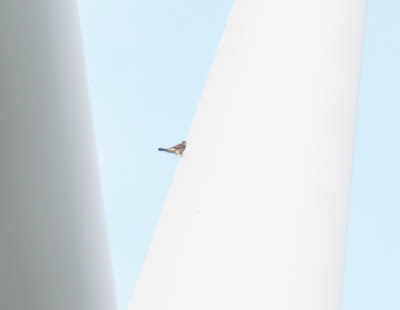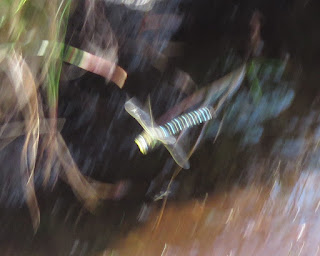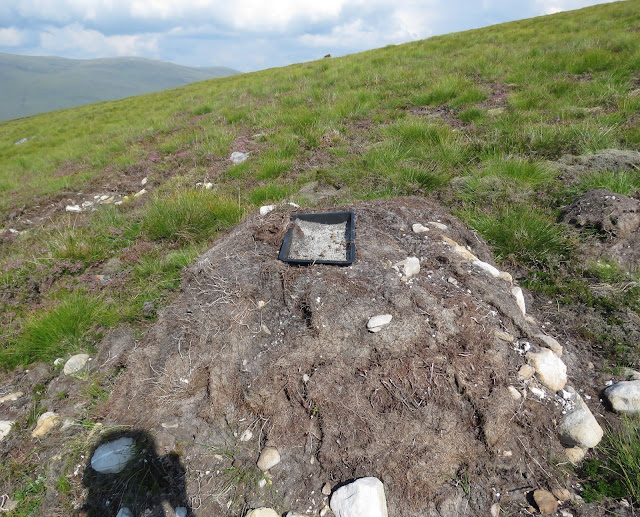Tuesday, July 27, 2021
Beinn Liath Mhor a' Ghiubhais Li - for the sixth time!
Yesterday: We used two cars again and followed the route we took in April, along the ridge from the wind farm to the Corbett - its name meaning "big grey hill of the coloured pine" (walkhighlands.co.uk). A mountain hare was seen at the edge of the moorland. A small raptor had me flummoxed - merlin or kestrel? I think the fanned tail is pretty long, and when the bird landed momentarily on the blade of a wind turbine, it seemed to show the colouration of a male kestrel - although the fine barring on the tail suggests a female.
Instead of traversing the flank of a named top (Beinn Liath Bheag) as we did last time, joining the ridge further along, we went straight upwards to gain the summit. Glad we did as it's a nice top. I clicked off two shots, one looking back at the wind-farm and one looking ahead as Greger set off again.
A persistent faint piping call betrayed the presence of golden plover, and an adult bird flew up from the heather and landed for a while on a lookout point to see us off its territory.
A large herd of red deer seen at a distance seemed to be mostly hinds with well-grown calves, although a few stags were also present. Much closer were two juvenile wheatears.
There were quite a few meadow pipits around - but this bird, one of two on the top where we had lunch, looks in some ways rather like a tree pipit. Dunno. (Later: I think it's a young meadow pipit.)
We reached the final, highest top of the ridge and made our way slowly down; and just when I'd given up hope of seeing ptarmigan, I glanced over to the right and spotted one against a jumble of pale rocks.
I'm ashamed to say I wasn't thinking about any young she might have, and when Greger pointed out that there were chicks present I thought he'd made a mistake - surely those birds taking to the air couldn't be ptarmigan chicks? But they were. (The BWP states that ptarmigan chicks are "capable of precocious flight at 10-15 days". Amazing.) Just one showed the relaxed attitude characteristic of its species to intruders by simply walking away - and then turning to have a good look at us before continuing down the hillside until just the top of its head could be seen. Anyway, the little family didn't go far, and there were no eagles in the sky.
It was a wrench to leave these lovely high places, especially as we knew that a tedious, steep, wet stretch awaited us before we reached the forest track; but we had to get back down to that road at some point so off we went again.
Among the peat hags - which were unusually dry - a small shrunken pool was brought to life by questing dragonflies - three common hawkers and a four-spotted chaser. My efforts at capturing them weren't very successful, but I can always pretend that with this image I was deliberately aiming for a stylised depiction of a common hawker; after all, it shows the main features of a brown-blue-yellow abdomen and a yellow leading edge to the wings.
Further down still, I was surprised to see a grit tray on top of what seemed to be a purpose-made mound of earth and rocks.
Grit trays are found on grouse moors - and I think the grit is often medicated. There are red and black grouse hereabouts, though we didn't see any today. Droppings in the tray show that it's being used, but which grouse species the droppings belong to, I've no idea - and in any case, the more numerous round droppings are those of hare.
I recalled the corvid trap that I'd seen on a recce of this route a year or so ago, and wondered if the estate was intensifying its grouse-shooting activities - although they surely can't be of the "driven" variety. I'd always thought that walked-up grouse shooting was a bit more "natural", although I'd rather they didn't do it at all. My heart sank - something "farmy" had arrived where once it was wild.
The tedious last stretch of hillside having been negotiated, we set off down the track through Altan Wood. A golden-ringed dragonfly was patrolling here, and further down we encountered an azure hawker - which seemed to be feeding on a crane fly.
The Fannichs car park was busy, so quite a few people were walking today - but we'd seen no-one on our hill. Although the last part of the walk had been done in warm sunshine, back at Ullapool we found the low cloud of the previous day hadn't lifted; and we might have found this depressing if we hadn't been so absolutely knackered.
A postscript: When I sat writing this walk up this morning, I felt something on the back of my neck and pulled it away from my hair thinking it was a tick. I found this - a deer ked - which has shed its wings, so must have thought it had reached its host. How did it survive two hot showers - one last night and one this morning?!
A reminder that not all close encounters with wildlife are agreeable.














